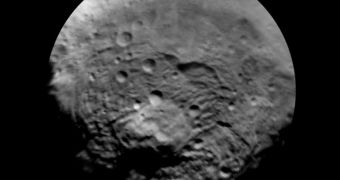The latest data sent to Earth by the NASA Dawn space probe – currently in orbit around the giant asteroid Vesta – indicate that a massive mountain exists on the object's southern hemisphere. In addition, the spacecraft also found an unexpected level of geological diversity on the object.
According to the principal investigator of the Dawn mission, Chris Russell, the newly-discovered landscape feature is almost as high as Olympus Mons, the tallest mountain in the solar system, which is located on the surface of the Red Planet.
The NASA orbiter arrived at Vesta in mid-July, and promptly began its year-long mission at the largest asteroid in the solar system. After spending some time in a survey orbit, it recently moved into a high altitude mapping orbit (HAMO), which is closer to the object's surface.
Dawn was able to estimate that the new mountain soars just under 15 miles (24 kilometers) above Vesta's surface. The largest mountain and volcano on our planet is Hawaii's Mauna Loa, which is about 6 miles (9 kilometers) high. However, this measure also includes its underwater segment.
Mount Everest is only 5.5 miles (8.85 kilometers) high, which means that it is dwarfed by either Olympus Mons or Vesta's largest peak. “We are learning many amazing things about Vesta, which we call the smallest terrestrial planet,” Russell explained.
“Like Earth, Mars, Venus and Mercury, Vesta has ancient basaltic lava flows on the surface and a large iron core. The south polar mountain is larger than the big island of Hawaii, the largest mountain on Earth, as measured from the ocean floor,” he adds.
Additional data from Dawn indicate that the surface of this particular asteroid is a lot rougher than that of any other space rock in the Inner Asteroid Belt. This portion of the solar system stretches between the orbits of Mars and Jupiter.
During a presentation held on October 3 at the 2011 European Planetary Science Congress and the Division for Planetary Sciences Joint Meeting, in Nantes, France, investigators also suggested that Vesta's southern hemisphere was a lot younger than its northern counterpart.
Data indicate the former to be only 1 to 2 billion years old. However, Vesta started forming during the earliest days of the solar system, around 4.5 billion years ago. The entire asteroid is about 330 miles (530 kilometers) in diameter.
“The variation in Vesta's brightness as the sun angle changes indicates that the surface of Vesta is very rough, causing light to scatter,” Raymond explained in a statement, as quoted by Space.
“This roughness could be at the scales of surface features or at the scale of individual minerals in the rocks, or both. Vesta's roughness is larger than most asteroids in the main asteroid belt,” he concludes.

 14 DAY TRIAL //
14 DAY TRIAL //